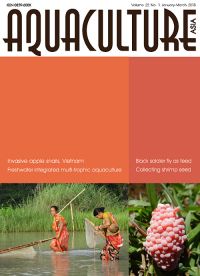A review of fresh water integrated multi-trophic aquaculture: Catching up on the dream of a blue revolution in India
13 March 2018 | Tarang Kumar Shah and Sapana Rani Charak | 3101 Downloads | .pdf | 546.14 KB | Freshwater finfish, Inland aquaculture, Aquatic plants, Molluscs (shellfish and other), Environment and Sustainability, India
Integrated multi-trophic aquaculture is a flexible concept, on which many variations can be developed and should not be viewed as confined to open-water, marine systems. Freshwater integrated multi-trophic aquaculture, perhaps better known as aquaponics, applies the same principles as those used in marine integrated multi-trophic systems. It is not only important for branding purposes, but can also increase the sustainability of the industry by reducing water usage and waste production, increasing product diversification, and can improve the societal acceptance of the industry. In particular, using plants to reduce phosphorus (and other nutrient) levels in effluents can help farmers meet water quality guidelines and prevent eutrophication in the environment.
Creative Commons Attribution.

